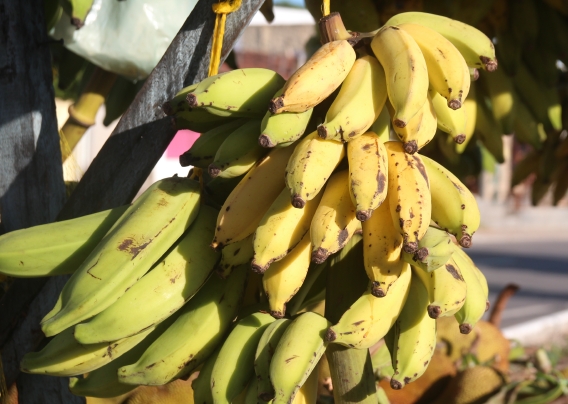
Banana - Types, benefits and recipes of this Brazilian delicacy
Banana is a fruit of undeniable nutritional value, represents a great source of energy of fast absorption and easy digestion.
Banana is one of the most consumed fruits in the world. It is the fourth most produced food product on the planet, after rice, wheat and corn. It was introduced in Brazil in the 16th century, since before its discovery and today it is found throughout the national territory and in numerous varieties. Our country is the second largest producer and consumer of banana in the world, losing only these two requirements to India.
According to the FAO, in 2005 the national consumption of bananas reached 29.2 kg / inhabitant / year, surpassing all other fruits, except orange, since it is appreciated by people of all social classes and of any age.
There are numerous species of this fruit, however, the best known for consumption are:
• Banana-gold:
Known in the north and northeast of the country with the name of "inajá", one of the most cultivated. It measures 5 to 7 cm. It is slightly curved. Its sweet flesh has a pleasant and characteristic flavor, very used to make croquettes. It has 112 calories in every 100 grams.
• Banana nanica:
in other regions, is called water banana. The size varies from 12 to 20 cm. It is the most cultivated, mainly in São Paulo. Quite used in pastries and cakes. It is slightly laxative and has 92 calories per 100 grams.
• Silver banana:
It is the most popular, measuring from 10 to 15 cm. It has a consistent and less sweet pulp than the banana-nanica, being the most suitable for frying. There are 98 calories per 100 grams.
• Banana Apple:
Measures 5 to 10 cm. Because it is more digestive, it is best for newborns. Contains 87 calories per 100 grams.
• Banana-land:
It is the largest among the varieties. For reasons of digestibility, it should be consumed cooked, fried or roasted. It has 128 calories per 100 grams.
Banana is a fruit of undeniable nutritional value, represents a great source of energy of fast absorption and easy digestion due to its carbohydrate content. It contains mainly vitamins A, B and C, as well as minerals such as potassium, magnesium, calcium and iron.
Vitamin A (beta-carotene), necessary for the immune system to function, helps prevent and reduce the duration of disease. But vitamin C (ascorbic acid), in addition to boosting immunity, is antioxidant, offering protection against cancer. Finally, the B vitamins: B2 (riboflavin) and B6 (pyridoxine), important for the functioning of metabolism.
Regarding minerals, its forte is the great amount of potassium, necessary for muscle contraction, avoiding muscle cramps and fatigue, as well as changes in heart rate. It is one of the fruits with the highest concentration of this mineral (100 grams of banana-nanica = 376 mg), according to the Brazilian Table of Food Composition - TACO. Potassium also helps in the transmission of nerve impulses and recomposes the loss of this mineral in cases of diabetes and helps patients with hypertension or heart problems.
Considered a low glycemic index food, that is, maintains the balance of blood glucose levels, banana also contributes to the prevention and control of diabetes and weight loss.
It is important to remember that banana does not cause constipation (constipation) unless it is green, instead, when it is well ripe it favors the formation of the faecal cake because it is rich in dietary fiber.
In turn, green banana has a higher amount of resistant starch and less sugar, thus helping to prevent the accumulation of body fat, since it allows a lower intake of food due to increased satiety. Studies also indicate that the regular consumption of resistant starch acts in the reduction of blood cholesterol, preventing the development of cardiovascular diseases and in the health of the intestine, by forming a protective barrier. The green fruit is also recommended in the treatment of infant dehydration, controlling diarrhea.
The banana can be consumed in natura, roasted, cooked, frozen, with cereals, sugar and cinnamon, in syrup, porridges, cakes, puddings and pies, accompanying hot and cold, salty and sweet dishes. The banana still allows the elaboration of some industrialized products as: concentrate of green banana pulp (biomass); green banana flakes (banana chips); banana powder; dehydrated banana; banana banana in syrup; jellies and ice creams.
Have you ever thought of making a chocolate fondue using biomass? So can you? Helps combat mood swings in PMS due to the presence of key nutrients in the production of serotonin.
By Andreia Cristina. Master in Food and Nutrition - CRN 3/19360. Originally published in the Bora Magazine - issue 11 - Apr / May 2015
Chocolate fondue recipe with green banana biomass
Ingredients
1 cup of bittersweet chocolate
1 cup of green banana biomass
½ cup (tea) coconut milk
Wash the green bananas well with the peels and place them in a pressure cooker with boiling water (what is needed to cover all the bananas). Cook the bananas in bark for 8 minutes, turn off the heat and allow the pressure to come out completely. Gradually peel the bananas and immediately put the blender into a puree. In this recipe you will use only one cup. The rest can be frozen. In a saucepan, combine all the ingredients and cook over low heat, stirring until the chocolate melts. If you like, add a spoonful of liqueur of your choice and stir well until smooth. Serve with chopped fruit.







 ESPAÑOL
ESPAÑOL
 PORTUGUES
PORTUGUES